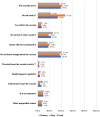HPV Vaccine Knowledge and Hesitancy Among Health Colleges' Students at a Saudi University
- PMID: 38024130
- PMCID: PMC10656864
- DOI: 10.2147/JMDH.S438633
HPV Vaccine Knowledge and Hesitancy Among Health Colleges' Students at a Saudi University
Abstract
Introduction: Human papillomavirus (HPV) infection is a widespread sexually transmitted infection linked to various types of cancer. Although vaccination against HPV is available, global HPV vaccination rates remain low.
Aim: This study aimed to evaluate the awareness and knowledge of the HPV vaccine and to identify predictors associated with vaccine hesitancy among health college students at King Saud University, Saudi Arabia.
Methods: A cross-sectional survey was distributed during December 2022 to students enrolled in health colleges. The survey link was randomly distributed via social media platforms and in-person interactions. The number of participants was 405 including both males and females. The data was analyzed using the Statistical Package for Social Sciences (SPSS). The correct response rate for all knowledge items was calculated, and they were stratified by gender and college. The association of vaccine hesitancy with sociodemographic characteristics was examined using logistic regression analysis.
Results: The study found that approximately half of the students (49.9%) were aware of the HPV vaccine. However, only a small percentage of students answered all to all HPV knowledge items correctly. Additionally, only a small proportion (5.2%) reported receiving the vaccine. The overall HPV vaccine hesitancy was 59.1% (43.9% for female and 75.9% for male). The most common reasons for vaccine hesitancy was not knowing enough about it. Males were two times more likely than females to believe that they did not need the HPV vaccine. The odds for HPV vaccine hesitancy were greater among males and younger age groups compared to females and older age groups.
Conclusion: This study underscores the importance of implementing university-wide interventions and educational campaigns to enhance awareness and knowledge of the HPV vaccine.
Keywords: HPV vaccine; college students; vaccine awareness; vaccine hesitancy.
© 2023 Aldawood et al.
Conflict of interest statement
The authors report no conflicts of interest in this work.
Figures



References
-
- Jemal A, Edgar P, Dorell C, et al. Annual report to the nation on the status of cancer, 1975 – 2009 featuring the burden and trends in human papillomavirus (hpv)– associated cancers and hpv vaccination coverage levels. J Natl Cancer Inst. 2013;105(3):175–201. doi:10.1093/jnci/djs491 - DOI - PMC - PubMed
LinkOut - more resources
Full Text Sources

